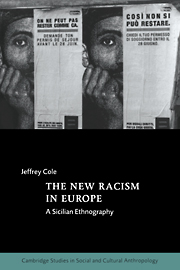Book contents
- Frontmatter
- Contents
- List of illustrations
- Acknowledgments
- Map
- 1 Introduction
- 2 When the bottom looks down: working-class views of immigrants in Palermo
- 3 The view from the top: bourgeois views of immigrants in Palermo
- 4 The politics of race and immigration in the Italian north and south
- 5 Conclusions
- Appendix
- Notes
- References
- Index
- Cambridge Studies in Social and Cultural Anthropology
1 - Introduction
Published online by Cambridge University Press: 12 October 2009
- Frontmatter
- Contents
- List of illustrations
- Acknowledgments
- Map
- 1 Introduction
- 2 When the bottom looks down: working-class views of immigrants in Palermo
- 3 The view from the top: bourgeois views of immigrants in Palermo
- 4 The politics of race and immigration in the Italian north and south
- 5 Conclusions
- Appendix
- Notes
- References
- Index
- Cambridge Studies in Social and Cultural Anthropology
Summary
Questions
Italy, long a country of emigration, has become a country of immigration in the past two decades with the arrival of nearly one million Africans, Asians, and others. This transformation has surprised politicians and citizens, who had come to regard emigration as part of Italian life. This change is particularly striking in the southern region of Sicily. For most of the last 100 years, oppression and poverty have generated waves of emigration from Sicily, first overseas and later, in the postwar period, to the Italian north and to western Europe. For much of this century, one out of every eight Italian emigrants was a Sicilian; and in the decade 1951–61 alone nearly 400,000 Sicilians left home (Renda 1989: 122–3; 18). From Brooklyn to Toronto, from Milan to Frankfurt, Sicilians have built bridges, dug tunnels, and constructed office buildings; and, as even the casual tourist knows, they have brought their shops, bakeries, and restaurants to far-flung Little Italies.
The 1970s witnessed a profound change in migratory patterns as many Sicilians returned and newcomers arrived. Among the first to arrive were Tunisians, who toiled in the fields, vineyards, and fisheries. Cape Verdian, Mauritian, and Filipino women served as domestics in homes of the urban rich. In the course of the 1980s some two dozen other nationalities, mostly from Africa and Asia, joined them, swelling the ranks of immigrants to about 15,000 in Palermo alone (Giornale di Sicilia, 6 September 1990).
- Type
- Chapter
- Information
- The New Racism in EuropeA Sicilian Ethnography, pp. 1 - 24Publisher: Cambridge University PressPrint publication year: 1997
- 6
- Cited by



